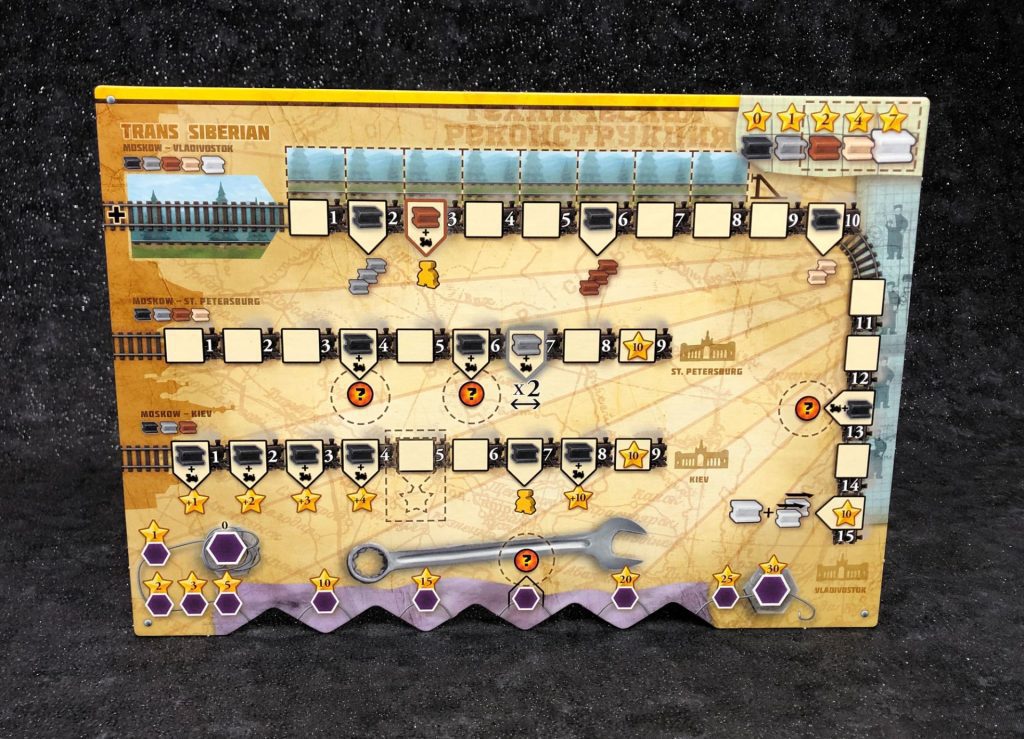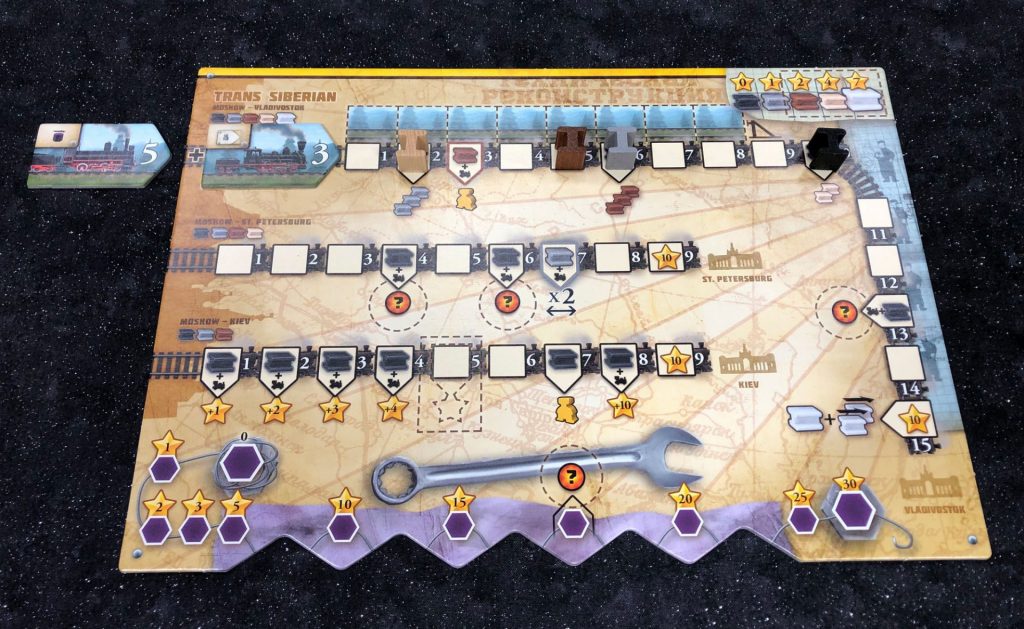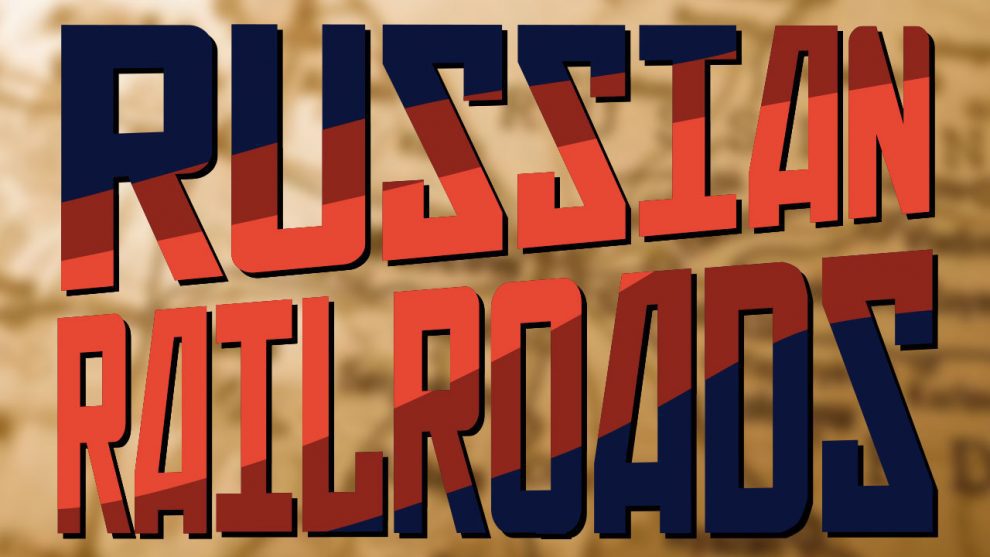Russian Railroads, the beloved 2013 game from Helmut Ohley and Leonhard Orgler, is quite possibly my favorite worker placement game. It is also, unambiguously and likely not coincidentally, the least forgiving worker placement game I have ever played. If too long to qualify as a knife fight in a telephone booth, Russian Railroads is a sword fight in a subway car, a vicious and reactive battle that has players competing to score the most points and build the best railways. Well. Scoring the most points, anyway.
“All Aboard!,” the Conductor Cried Out
During setup, every player receives five workers and a board depicting their three rail lines, which include the massive Trans-Siberian Railroad and two smaller lines going from Moscow to St. Petersburg and Kiev. Over the course of six or seven rounds, you will move girders—fancy cubes shaped like I-beams—along the slots on those tracks, expanding your railways towards their destinations. The further you get, so long as you remember to upgrade your locomotives, the more points you will score and the more bonuses you will receive.

The bottom of each player board hosts a fourth track, the Industry track, alternating between spaces worth points and modular spaces players fill in themselves, which will offer different bonuses. The customizable nature of the track means players who focus on developing their Industry can have quite a bit of control over the types of advantages they receive during the game.
In addition to the player boards, a central board depicting the available action spaces is set out in the middle of the table. These spaces allow players to move girders and along the Industry track, upgrade locomotives, claim the first player position for the next round, take coins, and more. The spaces cost between one and three workers depending on the action and depending on when you get to it; the first player to upgrade a train only has to spend one worker to do so, while the second has to spend two.

During setup you will also deal out a number of engineers equal to the number of rounds being played. The engineers in the second and third position will be flipped over to reveal temporary action spaces that can be used the same as any other action space on the board. At the end of the round, all engineers scoot forward one slot, meaning the available actions change a little every round. The first engineer is available to hire for one coin, and the player who does so sets that engineer facedown by their board. For the rest of the game, that player alone can use the hired engineer’s action. These actions are usually a little cheaper and a little more powerful, but their best attribute in a game where plans can fall apart in an instant is that they are reliably yours.
Por Favor, Manténgase Alejando de las Puertas
Scoring for Russian Railroads is a byzantine process that happens at the end of each round. Your score is a function of the girders on your tracks—there are multiple girders in different colors and sizes, with the larger girders of greater value getting added later—and how far along the railroad you’ve moved them, combined with the total numerical value of the locomotives you have running on each of your three rail lines.
For example, let’s say you have a 5 and a 3 locomotive on the Trans-Siberian line, the only line with two locomotive slots. That means you will score points for each of the first eight spaces on that line, so long as they have a girder. The number of points each space is worth depends on which girder applies to it, with girders adding their value to their present space and any empty spaces behind them. The black girder is worth 0 points and serves only to activate bonuses along the way, but the silver, brown, tan, and white girders are worth 1, 2, 4, and 7 points respectively. Let’s use a photographic example.

The black girder is on 10, the silver is on 6, the brown is on 5, and the tan is on 2. You wouldn’t score any points for spots 8 and 7, because the black girder isn’t worth anything. You get one point for 6, because of the silver girder. You get two points for spots 5, 4, and 3 because of the brown girder. Finally, you get four points for spots 2 and 1 because of the tan girder. Your total score for the line is 15 points. There are upgrades you can unlock during the game that change everything I just said, but we are not going into that today because I write these reviews for free.
Oh, I should mention that you also get points for your Industry track, but that’s easy; you get points equal to the value of the last scoring space you were on.
There are upsides and downsides to this system. If you play well, your score will increase significantly with each round. By the end of the game, you may get to watch your score marker do full laps of the scoring track as you rack up 200+ points. It can be a dizzying high. The downsides are important, though. First, this system isn’t intuitive for most people, so it’s easy to misjudge how well you’re doing until you score 30 points in a round where your opponents are pushing 100. The other issue is the effect adding up the scores has on the game’s momentum; with experienced players, the rounds are so zippy and reactive that stopping to add up your points can let some of the air out of the tires.
To Sleep, Perchance to Theme?
As you may have noticed, Russian Railroads is not a particularly thematic game. There’s a train on the box, you’ve got those I-beams, and ostensibly you’re working to upgrade the railway cars on your three railroad lines, but the theme is entirely incidental. This is an abstract game with a budget. This is a Holma af Klint painting cropped into the shape of a caboose. If Flamme Rouge evokes the feeling of a bicycle race in the mountains of France, or Caverna accurately recreates the domestic bliss of good dwarven living, Russian Railroads is as evocative a depiction of running a railroad line in Soviet-or-possibly-Pre-Soviet-but-this-is-really-just-reinforcing-my-point Russia as Hive is an accurate depiction of an insect colony.

In my opinion Railroads is no worse for that, but abstract games do seem to evoke a certain kind of response in a lot of people. It’s almost as though the gaming community at large has decided Russian Railroads is so exceptional that we’re all going to pretend it has a theme so nobody has to feel embarrassed. So long as I get to keep playing, I am fine with that.
I Choo-Choose You
Russian Railroads is a demanding, rewarding, mathy, abstract, highly interactive and cutthroat game that rewards patience, familiarity, and decision tree thinking. That may not sound like your kettle of fish, and I don’t blame you if it isn’t. Lord knows it has proven divisive in my playgroup. One friend found our plays deeply absorbing, but not in the least bit fun. Another played so poorly in his one game that he doesn’t remember ever having played it, an admirable coping mechanism. Not only is it sharp, it is a game you can play badly, something the current state of the hobby has left many of us ill-prepared to experience. It’s the kind of game where you have to know what your opponents are up to, anticipate their moves correctly, and know how to cope when you inevitably anticipate the wrong thing. It is not for everyone, but it isn’t trying to be. I absolutely adore it.












Add Comment